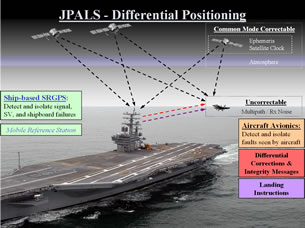Joint Precision Approach
and Landing System: JPALS
 |
The Joint Precision
Approach and Landing System (JPALS) is a key
component enabling U.S. military forces to be highly mobile
and capable of "rapid response" on a global
basis to a wide range of military scenarios. Similar in
concept to the civilian Local Area Augmentation System
(LAAS), JPALS will be based on differential Global Positioning
System (GPS) technology, and will consist of modular avionics
and ground/shipboard components to provide a range of
landing minima and system configurations. Aircraft will
receive ranging and navigation data from the satellite
constellation and differential ranging data or corrections
from a ground/shipboard station via a data link. JPALS
must remain operational throughout a range of threat environments,
and with performance requirements tailored to supporting
a highly mobile force at all locations, including an austere
forward operating area worldwide. |
Stanford University is leading a multi-disciplinary, multi-university
team (which includes The Illinois Institute of Technology
and the University of Minnesota, Twin Cities) in support of
United States Navy and Air Force JPALS system definition and
trade studies. Stanford's contribution is primarily in the
following three areas:
RESEARCHERS
| Faculty |
Prof.
Per Enge |
|
|
|
|
| Staff |
Dennis Akos
|
Ming Luo
|
|
Jennifer Gautier
|
Sam Pullen
|
|
|
|
| Students |
Santiago Alban
|
Ung-Suok Kim
|
|
Tsung-Yu Chiou |
David De Lorenzo
|
|
Mike Koenig
|
|
SUMMARY
The
Aeronautics and Astronautics Department at
Stanford University is internationally recognized for
academic and research excellence, and the
GPS Laboratory plays an increasingly important role in
developing and demonstrating new capabilities for space-based
navigational systems. In addition to fundamental advances
in positioning and navigation technologies, the Lab plays
a critical role in the operational readiness of the Wide Area
and Local Area Augmentation Systems (WAAS
and LAAS). The GPS
Lab includes recipients of the Charles Stark Draper Prize
(2003), the Johannes Kepler Award (1991 and 2000), and the
Thurlow Award (1986 and 1996). For further information on
Stanford University’s GPS Laboratory, please contact Prof.
Per Enge; for information on JPALS research, please contact
Dr. Jennifer Gautier.
PRIMARY COOPERATING GROUPS
University
of Minnesota: Prof.
Demoz Gebre-Egziabher
Navigation
and Guidance Laboratory at Illinois
Institute of Technology: Prof.
Boris Pervan
ARINC
:
Bruce Peterson and Fred Ventrone
top
|

